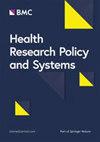在越南实现全民医保:结核病患者加入社会医疗保险的混合方法案例研究
IF 3.6
2区 医学
Q1 HEALTH POLICY & SERVICES
引用次数: 0
摘要
越南实现全民医保(UHC)可持续供资和财政保护的主要机制是社会医疗保险(SHI)计划。越南在实现全民医保方面取得了稳步进展,到 2020 年,超过 90% 的人口参加了社会医疗保险。2022 年,作为向增加国内医疗保健资金这一更大转型的一部分,结核病(TB)服务被纳入了社会医疗保险。这一变化要求结核病患者使用社会医疗保险在县级医疗机构接受治疗,或自付服务费用。本研究就是为这一转变做准备的。研究旨在进一步了解未参保肺结核患者的情况,评估将他们纳入社会医疗保险的可行性,并确定他们在此过程中面临的障碍。2018 年 11 月至 2022 年 1 月期间,在越南河内市和胡志明市的十个区采用收敛平行设计开展了一项混合方法案例研究。通过一项旨在促进未参保肺结核患者加入社会医疗保险的试点干预措施收集了定量数据。对数据进行了描述性统计。对 34 名参与者进行了定性访谈,这些参与者是有目的性地抽取的,以实现最大程度的差异。通过归纳法对定性数据进行分析,并通过框架分析确定主题。对定量和定性数据来源进行了三角测量。我们尝试将 115 名未参保的肺结核患者纳入社会保险计划;76.5% 的患者得以加入。平均而言,获得 SHI 卡需要 34.5 天,每户花费 66 美元。这些主题表明,缺乏知识、年度保费高昂以及以家庭为单位的登记要求是加入社会医疗保险的障碍。与会者指出,要在城市中心实现社会保险的全覆盖,就需要有其他的参保机制和更大的程序灵活性,特别是对无证人员而言。与会代表发现,结核病患者在加入社会医疗保险(SHI)方面存在重大障碍。由于缺乏所需证件,四分之一的人在接受强化支持后仍无法参保。其他中等收入国家在处理为传染病治疗提供财政保护的问题时,可以借鉴在这一卫生筹资转型过程中获得的经验。本文章由计算机程序翻译,如有差异,请以英文原文为准。
Towards universal health coverage in Vietnam: a mixed-method case study of enrolling people with tuberculosis into social health insurance
Vietnam’s primary mechanism of achieving sustainable funding for universal health coverage (UHC) and financial protection has been through its social health insurance (SHI) scheme. Steady progress towards access has been made and by 2020, over 90% of the population were enrolled in SHI. In 2022, as part of a larger transition towards the increased domestic financing of healthcare, tuberculosis (TB) services were integrated into SHI. This change required people with TB to use SHI for treatment at district-level facilities or to pay out of pocket for services. This study was conducted in preparation for this transition. It aimed to understand more about uninsured people with TB, assess the feasibility of enrolling them into SHI, and identify the barriers they faced in this process. A mixed-method case study was conducted using a convergent parallel design between November 2018 and January 2022 in ten districts of Hanoi and Ho Chi Minh City, Vietnam. Quantitative data were collected through a pilot intervention that aimed to facilitate SHI enrollment for uninsured individuals with TB. Descriptive statistics were calculated. Qualitative interviews were conducted with 34 participants, who were purposively sampled for maximum variation. Qualitative data were analyzed through an inductive approach and themes were identified through framework analysis. Quantitative and qualitative data sources were triangulated. We attempted to enroll 115 uninsured people with TB into SHI; 76.5% were able to enroll. On average, it took 34.5 days to obtain a SHI card and it cost USD 66 per household. The themes indicated that a lack of knowledge, high costs for annual premiums, and the household-based registration requirement were barriers to SHI enrollment. Participants indicated that alternative enrolment mechanisms and greater procedural flexibility, particularly for undocumented people, is required to achieve full population coverage with SHI in urban centers. Significant addressable barriers to SHI enrolment for people affected by TB were identified. A quarter of individuals remained unable to enroll after receiving enhanced support due to lack of required documentation. The experience gained during this health financing transition is relevant for other middle-income countries as they address the provision of financial protection for the treatment of infectious diseases.
求助全文
通过发布文献求助,成功后即可免费获取论文全文。
去求助
来源期刊

Health Research Policy and Systems
HEALTH POLICY & SERVICES-
CiteScore
7.50
自引率
7.50%
发文量
124
审稿时长
27 weeks
期刊介绍:
Health Research Policy and Systems is an Open Access, peer-reviewed, online journal that aims to provide a platform for the global research community to share their views, findings, insights and successes. Health Research Policy and Systems considers manuscripts that investigate the role of evidence-based health policy and health research systems in ensuring the efficient utilization and application of knowledge to improve health and health equity, especially in developing countries. Research is the foundation for improvements in public health. The problem is that people involved in different areas of research, together with managers and administrators in charge of research entities, do not communicate sufficiently with each other.
 求助内容:
求助内容: 应助结果提醒方式:
应助结果提醒方式:


